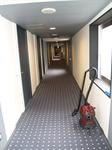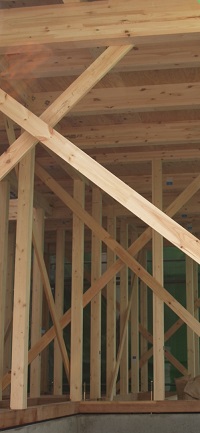Create a healthier environment to work or live in.
 Learn about toxins used all around us and how to avoid them.
Learn about toxins used all around us and how to avoid them.- Learn about choosing interior furnishings and finishes which do not have a negative effect on health.
- Understand how building location can affect health.
- Learn about air quality, temperature control, lighting, acoustics, and much more.
- Develop your knowledge to manage or consult on building interiors.
Many buildings contain hazardous materials or substances without the owner's knowledge. Freshly constructed cement homes can have high levels of moisture, homes built in the 1960's may contain asbestos cement and residues of toxic pesticides and old buildings were frequently painted with lead paints. In addition to the household disinfectants, fly sprays, paints, varnishes, and other fumes released from a large range of furnishings and commodities are of no benefit to the occupant's health.
This course helps you understand these and other environmental concerns that exist in both residential and commercial buildings; and how you might respond to such concerns.
COURSE STRUCTURE AND LESSON CONTENT
There are 8 lessons in this course:
- Environmental Impacts On Buildings
- Scope, nature and principles of building biology
- Environmental impacts on buildings
- Climate, building location, radon, air quality, allergies, temperature, humidity, light, EMR
- Creation of electric fields
- Chemicals
- Air pollutants
- Cleaning chemicals
- Chemical breakdowns
- Leakages and spills
- Pesticides -household, industrial, agricultural
- Solid Waste pollutants
- Persistent organic pollutants (POP's)
- Formaldehydes
- Heavy Metals
- Ammonia
- Resins
- Where different chemicals originate in a building
- Building Surrounds
- Creating a buffer zone
- Windbreaks, hedges, screens
- Creating Shade
- Designing a healthy home garden
- Going natural in the garden
- Avoiding problem materials
- Disposing of waste
- Making compost
- Working with rather than against nature
- Energy conservation
- Solar house design
- Green principles for house design
- Furnishings
- Gas appliances, heaters and fireplaces
- Furniture
- Materials characteristics
- Floor Coverings
- Cane
- Metals
- Fabrics
- Flame retardation treatments
- Mattresses
- Dry cleaning and mothballing
- Temperature and acoustic properties of fabrics
- Finishes
- Chemical reactions
- Lung disease, cancer, skin disease
- Paint
- Repainting
- Timber finishes against decay
- Varnishes and oils
- Pesticides & Alternatives
- Types of insecticides -inorganic and biological (organophosphates, carbamates etc.)
- Rodenticides
- Miticides, Bacteriacides, Algaecides, Termite treatments
- Understanding pesticide characteristics -toxicity, persistence, volatility, etc.
- Common chemicals used in buildings, and natural alternatives
- Common garden chemicals and natural pest/weed management
- Understanding Insect Pest Management options
- Managing Interior Environments
- Assessing air quality
- Ventilation
- Temperature control
- Cleaning
- Acoustics
- Electricity
- Domestic pets
- Light
- Colour
- Indoor Plants
- Other hazards
- Consulting
- Services that can be offered to a client
- Checklist of building hazards
- Procedures and business practice for a consultant
- Setting up costs
- Operating a business
- Developing a business plan
- Determining fees to charge
Each lesson culminates in an assignment which is submitted to the school, marked by the school's tutors and returned to you with any relevant suggestions, comments, and if necessary, extra reading.
COURSE AIMS:
 Explain the impact of the macro-environment (location) on health.
Explain the impact of the macro-environment (location) on health.- Develop an understanding of chemicals used in and around buildings and their impact upon human health.
- Explain the impact of building surrounds, including a garden on the interior environmental conditions.
- Choose interior furnishings that are not likely to damage human health.
- Explain the health implications of using different types of finishes, including sealers, paints, preservatives and stains.
- Explain the health implications of using alternative methods of pest control in buildings and adjacent gardens.
- Plan health-conscious management systems for interior environments.
- To develop an appreciation of the opportunities for, and implications of, advising people on the health status of buildings and recommending changes to the management of their use.
WHAT THE COURSE COVERS
 Explain how proximity to different bodies of water can affect human health, including: Sea/Ocean; Freshwater lakes; A river; Ground water.
Explain how proximity to different bodies of water can affect human health, including: Sea/Ocean; Freshwater lakes; A river; Ground water.- Explain how different aspects of prevailing weather patterns may influence house design in different regions, including: Temperature; Rainfall; Winds; Day length.
- Explain in a summary, how proximity to electromagnetic radiation may impact on health.
- Explain in a summary, how proximity to different types of pollution can impact on health inside a dwelling.
- Compare the impact of different garden treatments upon temperature inside buildings, including: Tall trees; Lawn; Paving; Mulched surfaces; Climbers on walls.
- Explain how different garden design decisions can affect ventilation in a house, including: Earth shaping; Planting; Constructions; Water features.
- Compare the affect different garden components on light inside a building, including: Plant types; How plants are grouped; Walls; Topography; Pergolas.
- Explain how the visual characteristics of two different gardens influence the inside environment of a building.
- Analyse two different gardens for the impact they have on buildings they surround.
- Compare health aspects of different materials used for furnishings including: Metals; Plastics; Timbers; Upholstery; Curtains.
- Compare health aspects of different floor coverings including: Tiles; Carpets; Vinyl; Cork; Slate; Timber.
- Explain health aspects of different electrical appliances including: Televisions; Computers; Refrigerators; Microwaves; Heaters; Air conditioners; Ovens.
- Evaluate the furnishings in a building inspected by the learner, to determine recommended changes to improve building habitability.
- Compare the health affects of different types of finishes including: Sealers; Paints; Stains; Preservatives; Varnishes.
- Compile a resource directory of ten sources of healthy alternatives to traditional finishes.
- Describe the characteristics of three different specific products which are healthy alternatives to traditional paints and finishes.
- Explain the toxic affects of ten different pesticides commonly used in buildings, both during and after construction.
- List alternative "healthier" methods of controlling pests in buildings, including: Rodents; Ants; Termites; Flies; Cockroaches.
- Develop a detailed pest control strategy for a building, in the learners locality, which includes: Structural treatments during and post construction; Preventative measures for anticipated problems; Eradication measures for existing problems.
- Explain issues of building usage which can impact on health with respect to different factors including: Number of people; Electricity; Windows and doors; Cooking; Smoking; Curtains; Hygiene.
- Analyse the way two specific buildings including a home and a workplace are used to determine health risk factors in that use.
- Recommend guidelines to the way in which different buildings, including an office, and a workplace, are used, to minimise negative impacts upon health.
THIS COURSE IS SUITABLE FOR
The Building Environment and Health course provides a solid foundation of knowledge that can be applied to your own home, health and fitness centres, workplaces - in fact any building where people live, work, socialise, or exercise.
The course will develop your ability to evaluate and consider elements that have an effect on the contribution of a buildings interior to the health of those within it.
It is suitable for:
- Interior designers.
- Builders and building renovators.
- Building managers.
- Interior consultants.
- Building management companies.
- Home-owners.
You can enrol and start the course at any time. It is studied by distance learning, either online or by eLearning.
Find out more - get in touch with our specialist Health and Fitness tutors today. They will happily answer your questions, explain more about our courses, and consider suitable study options for your goals.